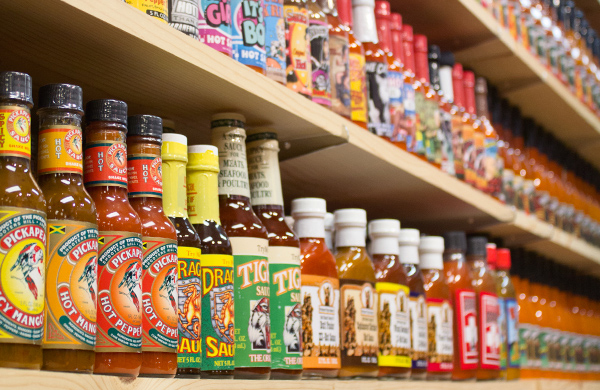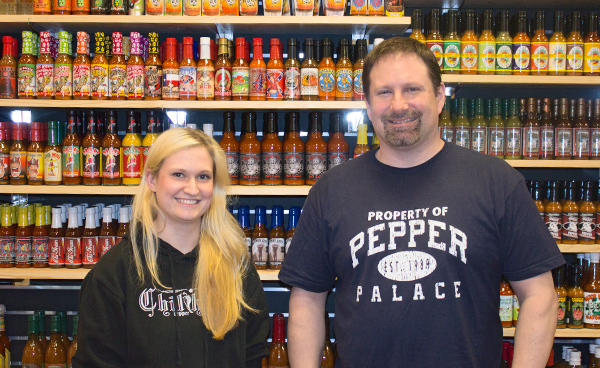
Goldfish crackers are the most docile snack food, so they seemed the perfect medium for an experiment. I gathered a handful of coworkers into a conference room and loosened the unassuming hot-sauce cap. With a pinprick of red dabbed on each respective fish, we collectively chomped down. The results were instant.
“It tastes like mustard gas.”
“It feels like I flossed too hard, and now my gums are bleeding.”
My experience was far worse. In a rush of morbid curiosity, I downed half a cap of the stuff. It gave me full-body shakes, chest pain, dizziness, and about an hour of regret.

This tongue-killer is called The Hottest Sauce in the Universe. It’s not the most humble of names, but it’s appropriate given its reigning title as the hottest hot sauce on the globe (depending on who you ask). Each batch is made from 40 pounds of ghost chilies, compressed and cooked down until the liquid measures a whopping 3.5 million Scoville heat units. To put this in perspective, Tabasco sauce measures 50,000 SHU and jalapeños a mere 5,000.
Connoisseurs of Pyromania
The brewer of this crimson death wish is distributor King of Fire, which stocks shelves at The Pepper Palace’s 20 stores. I bought my bottle at Chicago’s Water Tower Place location. The shop is pretty impressive. More than 1,000 bottles line the walls like sparkling red sticks of dynamite. There are several tasting areas to sample sauces and salsas, but nothing too dangerous. For the heavy stuff, you have to talk to the folks behind the counter. That’s where I met O’Neill Ryan, owner of the shop.

His handshake was firm and his smile devilish. I wanted to know the ins and outs of the business, sure, but I was more curious about the danger of his products, specifically the side effects. He gets the question a lot.
"Hiccups, watering of the eyes, sweating profusely,” he said, laughing. "Some [people] start to lose their hearing because it's all connected through the sinuses.”
He then let me try something called Nasal Napalm Horseradish, which I can only describe as a searing nose explosion. “Crazy, right?” O’Neill said. “It’s a rite of passage of every new employee. Welcome.”
He grew serious, though, when stressing that hot-sauce aficionados care about subtlety, too. “Honestly, it’s more about the flavor,” he said. “It’s very similar to wine. But instead of grapes, it's chilies.”
He went on to explain that chilies, too, have complex and distinct varietals. Comparing jalepeño peppers to ghost chilies, he says, isn’t so different from comparing merlot to pinot noir. Sales associate Meghann added that spice is something you build tolerance to, and as you do, the complexities of any given recipe become easier to discern.
As a wine lover myself, the analogy made a ton of sense. But as a human, something didn’t sync. Five minutes after trying that Nasal Napalm, it wasn’t the flavor that lingered on my tongue—it was my pulse. While O’Neill talked wine, my heart clunked. My pupils dilated. The red bottles closed in on me with their labels’ cartoonish renderings of Satan, mushroom clouds, and erupting volcanoes. To hell with the flavor. This stuff is a pure adrenaline.
The Science Behind the Rush: Why You’d Eat This On Purpose
Capsaicin is a colorless compound located in the veins of the chili (not the seeds, as is popularly thought). This is what gives chilies their heat. If you’re feeling frisky, you can buy it online here in a pure form rated at 16 million SHU. Of course, capsaicin has been weaponized. The Indian military crafts grenades from ghost peppers, and law enforcement is notorious for using pepper spray. But at two million SHU, pepper spray is still not as strong as world’s hottest hot sauce by half. And yet we ingest the stuff freely. One need only YouTube “hot pepper” to find steel-spined masochists chomping ghost chilies, sweating, crying, and dry-heaving.
Is it all for the thrill?
Psychologist Paul Rozin thinks so. In his widely cited research paper on the subject of heat thrill-seeking, he noted eating chilies is “a ‘constrained risk’ like riding a roller coaster, in which extreme sensations like pain and fear can be enjoyed because individuals know that these sensations are not actually harmful.” That lets them “experience extreme feelings without any risk of bodily harm.”
A chemist might have another explanation for our love of spice. Believe it or not, uber-hot chilies are more likely to kill some kinds of pain than cause them. When capsaicin irritates the pain receptors in the mouth, nose, and stomach, the brain releases a chemical messenger to stimulate endorphins—a natural painkiller. So are these so-called “pyro-gourmaniacs” seeking to numb themselves from physiological—or mental—pain, or are they seeking a deeply visceral rush?
Here’s my two cents: I still taste the stuff.

Above, the in-office taste test. One writer described the hot sauce by saying: “It feels like I flossed too hard, and now my gums are bleeding.”
Sure, it was uncomfortable. The Goldfish fiasco took a flamethrower to my tonsils, leaving me crumpled in my desk chair. You could tenderize meat with my beating heart. But, in that dull conference room, the heat rattled my Tuesday free of its humdrum hinges, and for that, I was deeply grateful.
So I encourage you to take a trip to The Pepper Palace. Buy yourself a bottle of Endorphin Rush, Satan's Blood, or if you’re feeling rambunctious, The Hottest Sauce in the Universe. See what crying and coughing stirs up in your synapses.
For what it’s worth, I may shoot for a whole cap-full next time. This stuff is crazy.











